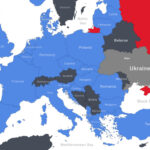Most of us are not aware that supposedly carbon-free energy sources–those that are acceptable to environmentalists–don’t work, writes Francis Menton at the Manhattan Contrarian. Acceptable to environmentalists are wind and solar. Not acceptable–nuclear and hydro.
Even worse, wind and solar are not even carbon-free, because it takes large amounts of carbon-based energy to make the turbines or panels or whatever. Put these two problems together, and governments that try to reduce their carbon emissions by heavily subsidizing wind and solar quickly hit a wall where energy prices for the masses soar through the roof even as the carbon emissions don’t go down. You won’t find the New York Times or Washington Post reporting on this, but it’s getting harder and harder not to notice.
A good example is Germany, the poster country for green energy.
“Transitioning” from fossil fuel energy to wind and solar has been the signature issue for Chancellor Angela Merkel for more than a decade … The entire country has fallen into the mass hysteria! (Has anything like that ever happened before in Germany? Don’t ask!) Germany has moved aggressively to cut its carbon emissions, and was a leader in the 2015 Paris negotiations in making aggressive promises of emissions reductions and in strong-arming other countries, including the United States, to commit to aggressive reduction targets. Germany is part of the EU commitment to 40% emissions reductions (from 1990 levels) by 2030, and in addition has its own internal goals of reaching the 40% reduction by 2020 (coming right up!) and 95% reduction by 2050. Impressive!
(Germany) hit the emissions reduction wall around 2010. Since then, its emissions have actually increased in 4 of the 7 years. Multiply out the changes since 2009, and you will find that Germany’s emissions at the end of 2016 were 99.79% of the level they had had at the end of 2009. This, despite the fact that 2010 was the year they passed the so-called “Energiewende” law. That’s some “energy transition” — 0.21% emissions reduction in seven years!
Back in the real world, Mr. Menton quotes Jamie Horgan in The American Interest, September 20, “Germany Will Miss Another Green Goal”:
Berlin’s grand green energy transition is falling short of the lofty targets that inspired it. Earlier this month, the think tank Agora Energiewende released a report that projected Germany would fall well short of its goal to cut greenhouse gas (GHG) emissions—far shorter than was previously believed. Berlin had committed to cutting 40 percent of its GHG emissions by 2020 as compared to 1990 levels, but as that year looms large, the country has achieved a reduction of “just” 28 percent (a remarkable decrease, though nowhere close to the target), and it’s expected to only shave off another 2 or 3 percent over the next few years. Now, a new study from the BEE renewable energy group suggests that the country is going to fall short of its Brussels-set target of sourcing 18 percent of its energy production from renewables by 2020.
Kudos to Mr. Hogan for publishing the above, but as F.M. points out, Mr. Hogan still got taken in with the 1990 date.
That 1990 date was intentionally picked by Germany to scam the rest of the world. 1989 is the year the Berlin Wall fell. Over the next decade and a half, the Germans shuttered essentially all of the inefficient Soviet-era heavy industry in East Germany. Germany picked the 1990 start date so that it could take credit for those reductions that would have happened anyway and pretend that this had something to do with saving the planet.
Germany’s stated goals of emissions reductions are just fantasies not to be achieved, writes Mr. Menton. Meanwhile prices for electricity and gasoline and heating oil will continue to soar. It should be no surprise that Germany’s residential electricity prices are already about triple the U.S. average, about on par with prices in California and New York.
Read more here.
If you’re willing to fight for Main Street America, click here to sign up for the Richardcyoung.com free weekly email.





